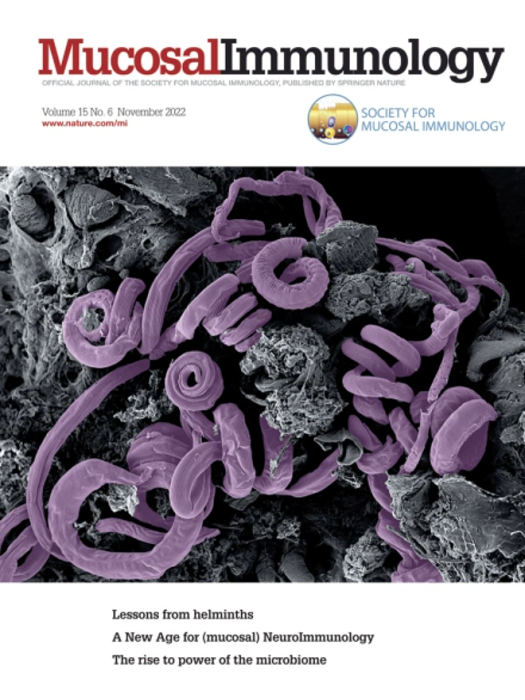病毒特异性CD8+ T细胞在人鼻腔中的动态变化。
IF 7.6
2区 医学
Q1 IMMUNOLOGY
引用次数: 0
摘要
鼻腔是呼吸道病毒的进入点。了解鼻腔如何维持记忆CD8+ T细胞对于改善呼吸道病毒管理和疫苗开发至关重要。在这里,我们从健康成人的上鼻甲和外周血中取样了CD8+ T细胞。我们分析了它们对呼吸道(SARS-CoV-2、流感)和非呼吸道(HCMV)病毒的转录组谱和抗原特异性。转录组学分析显示,鼻腔CD8+ T细胞在TCR刺激后无法上调STAT1,尽管IFN信号传导具有抗增殖作用,但仍有可能实现克隆扩增。它们还表现出细胞毒性,th1样的组织驻留标记,但缺乏TCF7表达,表明自我更新能力有限。CD8+ T细胞抗原特异性分析表明,局部鼻暴露对于病毒特异性CD8+ T细胞检测是必不可少的。鼻室中仅检测到SARS-CoV-2和流感特异性CD8+ T细胞,未检测到hcmv特异性CD8+ T细胞。然而,它们在鼻腔中持续存在的时间似乎与反复接触病毒有关。我们的研究结果提供了对鼻腔驻留CD8+ T细胞适应性的见解,并强调了引发持久鼻腔T细胞免疫的挑战,对针对呼吸道病原体的疫苗策略具有重要意义。本文章由计算机程序翻译,如有差异,请以英文原文为准。
Dynamics of virus-specific CD8+ T cells in the human nasal cavity
The nasal cavity is the entry site for respiratory viruses. Understanding how the nasal cavity sustains memory CD8+ T cell is essential for improving respiratory virus management and vaccine development. Here, we sampled CD8+ T cells from the upper nasal turbinate and peripheral blood of healthy adults. We analysed their transcriptomic profile and antigen specificity for respiratory (SARS-CoV-2, Influenza A) and non-respiratory (HCMV) viruses.
Transcriptomic analysis revealed that nasal CD8+ T cells failed to upregulate STAT1 following TCR stimulation, potentially enabling clonal expansion despite the antiproliferative effects of IFN signalling. They also exhibited a cytotoxic, Th1-like profile with tissue-residency markers but lacked TCF7 expression, suggesting limited self-renewal capacity. The CD8+ T cell analysis of antigen specificity demonstrates that local nasal exposure is indispensable for virus-specific CD8+ T cell detection. Only SARS-CoV-2 and influenza-specific but not HCMV-specific CD8+ T cells were detected in the nasal compartment. However, their persistence over time in the nasal cavity appears linked to repetitive viral exposure.
Our findings provide insights into the adaptations of nasal-resident CD8+ T cells and highlight challenges in eliciting durable nasal T cell immunity, with important implications for vaccine strategies against respiratory pathogens.
求助全文
通过发布文献求助,成功后即可免费获取论文全文。
去求助
来源期刊

Mucosal Immunology
医学-免疫学
CiteScore
16.60
自引率
3.80%
发文量
100
审稿时长
12 days
期刊介绍:
Mucosal Immunology, the official publication of the Society of Mucosal Immunology (SMI), serves as a forum for both basic and clinical scientists to discuss immunity and inflammation involving mucosal tissues. It covers gastrointestinal, pulmonary, nasopharyngeal, oral, ocular, and genitourinary immunology through original research articles, scholarly reviews, commentaries, editorials, and letters. The journal gives equal consideration to basic, translational, and clinical studies and also serves as a primary communication channel for the SMI governing board and its members, featuring society news, meeting announcements, policy discussions, and job/training opportunities advertisements.
 求助内容:
求助内容: 应助结果提醒方式:
应助结果提醒方式:


